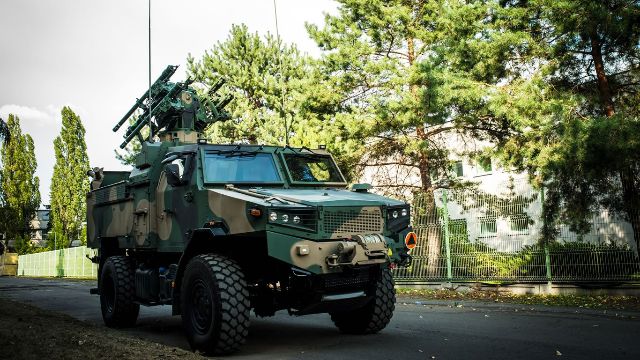At the upcoming International Defence Industry Exhibition [MSPO] 2025, Poland is set to showcase the prototype of its latest short-range air defense system, dubbed GRZMOT.

Developed to bolster the Polish Land Forces’ mobile units, this advanced very short-range air defense [VSHORAD] system is designed to counter low- and very low-altitude aerial threats with a reported engagement range of up to 12 kilometers.
Drawing on the technological legacy of the Piorun and Piorun NG missile systems, GRZMOT aims to enhance Poland’s layered air defense architecture, complementing existing systems like Poprad, Pilica/Pilica+, and Kusza.
The unveiling, anticipated to draw significant attention from global defense stakeholders, underscores Poland’s ongoing commitment to modernizing its military capabilities amid evolving regional security dynamics.
The GRZMOT system, developed by a consortium led by Mesko S.A., a key player within the Polska Grupa Zbrojeniowa [PGZ], represents a significant step forward in Poland’s indigenous defense industry.
According to posts on X, the system is engineered to engage a variety of aerial targets, including unmanned aerial vehicles [UAVs], helicopters, and fixed-wing aircraft, at altitudes ranging from 10 meters to approximately 4 kilometers. Its thermally guided missiles ensure precision targeting, even in contested environments with advanced countermeasures.
Designed for integration with various mobile platforms, GRZMOT offers rapid deployment and operational flexibility, making it a critical asset for dynamic battlefield scenarios. While official specifications remain limited pending the prototype’s reveal, the system is expected to incorporate cutting-edge optoelectronic and radar technologies, building on lessons learned from the Piorun series.
The GRZMOT’s missile, likely an evolution of the Piorun NG, is anticipated to feature a dual-mode seeker with enhanced resistance to infrared countermeasures, a hallmark of Mesko’s recent advancements.
The Piorun NG, showcased at MSPO 2023, introduced a new optoelectronic head, upgraded control software, and improved propulsion, extending its range to approximately 8 kilometers. GRZMOT’s reported 12-kilometer range suggests further refinements in propulsion and aerodynamics, potentially incorporating a more powerful rocket motor or optimized missile design.
The system’s ability to engage targets at very low altitudes is particularly significant, addressing the growing threat of small, low-flying drones, which have proven challenging in recent conflicts, including the war in Ukraine.
Integration with mobile platforms is a cornerstone of GRZMOT’s design. Unlike static air defense systems, GRZMOT can be mounted on vehicles such as the Jelcz 6×6 truck, a platform already used for systems like the AG-35 35mm anti-aircraft gun displayed at MSPO 2021. The Jelcz 6×6, with a payload capacity of up to 6 tons, offers a robust chassis for mounting missile launchers, radar, and command-and-control [C2] systems.
Measuring approximately 8 meters in length, 2.5 meters in width, and 3.2 meters in height, the Jelcz truck provides a stable platform with a maximum speed of 85 km/h and a range of 500 kilometers, ensuring mobility across varied terrains. This adaptability allows GRZMOT to keep pace with mechanized and airborne units, providing on-the-move air defense coverage.
The GRZMOT system is expected to include a compact radar, likely derived from PIT-Radwar’s Bystra or Soła radar systems, both of which are integral to Poland’s air defense network. The Soła radar, used in the Poprad system, operates in the S-band with a detection range of up to 40 kilometers for low-flying targets.
Its lightweight design, weighing approximately 1,200 kilograms, and ability to integrate with electro-optical sensors make it a candidate for GRZMOT’s sensor suite. The system’s C2 module will likely leverage Poland’s Integrated Air and Missile Defense Battle Command System [IBCS] compatibility, ensuring seamless data sharing with higher-tier systems like Wisła [Patriot] and Narew [CAMM].
This interoperability enhances situational awareness and enables coordinated engagements across Poland’s multi-layered air defense framework.
To understand GRZMOT’s role, it’s essential to examine the systems it complements. The Poprad, a VSHORAD system in service since 2015, is mounted on a Zubr 4×4 vehicle and armed with four Grom or Piorun missiles.
The Zubr, measuring 5.8 meters in length and weighing 7.5 tons, carries a GOS-1 optoelectronic head with thermal and TV cameras, enabling independent target acquisition.
Poprad’s range of 5.5 kilometers and altitude ceiling of 3.5 kilometers make it effective against UAVs and helicopters but less capable against faster or longer-range threats. GRZMOT’s extended range and advanced guidance systems address these limitations, offering a more versatile solution.
The Pilica/Pilica+ system, another pillar of Poland’s VSHORAD network, combines twin 23mm ZUR-23-2SP cannons with Grom/Piorun missiles. Deployed on an artillery tractor, Pilica’s fire unit weighs approximately 15 tons and includes a radar with a 40-kilometer detection range.
Its six fire units per battery provide robust localized defense, but the system’s reliance on shorter-range missiles restricts its engagement envelope. GRZMOT’s 12-kilometer range and mobile platform integration position it as a natural successor, capable of covering larger areas while maintaining rapid response capabilities.
The Kusza system, tailored for airborne operations, is mounted on the Aero 2 high-mobility vehicle, a 4×4 platform weighing 3.5 tons with a 1,200-kilometer range. Armed with two Piorun launchers and carrying additional missiles, Kusza is optimized for rapid deployment via parachute or helicopter sling.
While highly mobile, its range is limited to 6.5 kilometers, making GRZMOT’s extended reach a critical upgrade for protecting mobile units against more distant threats. Together, these systems form a cohesive VSHORAD network, with GRZMOT bridging gaps in range and flexibility.
Poland’s development of GRZMOT reflects lessons from recent conflicts, particularly in Ukraine, where low-cost drones and loitering munitions have reshaped air defense requirements.
The war, ongoing since 2022, has highlighted the need for systems capable of countering small, agile targets at low altitudes. GRZMOT’s thermally guided missiles and potential for swarm defense—possibly incorporating AI-based target tracking—position it as a response to these challenges.
Compared to Western equivalents like the U.S. Avenger system, which uses Stinger missiles with a 4.8-kilometer range, GRZMOT offers a longer engagement envelope and greater platform versatility. The Russian Pantsir-S1, with a 20-kilometer missile range, surpasses GRZMOT in reach but is heavier [30 tons] and less suited for rapid redeployment, underscoring GRZMOT’s niche as a lightweight, mobile solution.
The GRZMOT prototype’s unveiling at MSPO 2025 builds on Poland’s tradition of using the Kielce exhibition to showcase defense innovations. MSPO, held annually since 1993, has grown into one of Europe’s largest defense trade shows, attracting over 600 exhibitors and 20,000 visitors in 2024.
Past events have seen significant contracts, such as the 2016 Pilica deal valued at €174.5 million and the 2023 Narew agreement for over 1,000 CAMM-ER missiles. While no contract announcements for GRZMOT have been confirmed, the prototype’s debut could pave the way for production contracts, potentially valued in the hundreds of millions of euros, given the system’s complexity and Poland’s defense spending trajectory.
NATO estimates that Poland’s defense budget will be 5% of GDP in 2025, the highest in the alliance, signaling robust funding for such initiatives.
Mesko’s role in GRZMOT’s development underscores Poland’s growing self-reliance in defense manufacturing. The company, based in Skarżysko-Kamienna, has produced over 2,000 Piorun missiles since 2016, with exports to Ukraine and Lithuania demonstrating its reliability.
GRZMOT’s production could leverage Mesko’s existing facilities, which employ over 1,500 workers and span 120 hectares. Partnerships with PIT-Radwar for radar systems and CRW Telesystem-Mesko for optoelectronics further strengthen the project’s industrial base.
The system’s potential export appeal, particularly to NATO allies facing similar drone threats, could enhance Poland’s position in the global defense market.
Operationally, GRZMOT enhances the Polish Land Forces’ ability to protect maneuver units, airfields, and critical infrastructure. Its 12-kilometer range allows it to engage threats before they reach their targets, while its mobility ensures coverage during offensive or defensive operations.
The system’s integration with IBCS facilitates real-time data exchange, enabling commanders to prioritize targets across Wisła, Narew, and VSHORAD layers. In a hypothetical scenario, a GRZMOT battery could neutralize a swarm of UAVs targeting a forward operating base, coordinating with Narew’s CAMM-ER missiles to handle higher-altitude threats. This layered approach maximizes survivability and operational tempo, critical in high-intensity conflicts.
The GRZMOT’s development aligns with Poland’s broader air defense modernization, spurred by Russia’s invasion of Ukraine. Since 2022, Poland has accelerated acquisitions, including 48 Patriot launchers, 644 PAC-3 MSE missiles, and 23 Narew systems. GRZMOT’s role as a VSHORAD component ensures comprehensive coverage, from low-altitude drones to ballistic missiles.
Its reliance on domestic technology reduces dependency on foreign suppliers, a strategic priority given the supply chain disruptions observed during the Ukraine conflict. The system’s modularity also allows for future upgrades, such as laser-based countermeasures or extended-range missiles, ensuring long-term relevance.
As MSPO 2025 approaches, the GRZMOT prototype is poised to generate significant interest among defense professionals and policymakers. Its unveiling reflects Poland’s proactive stance in addressing modern battlefield threats, particularly the proliferation of low-cost aerial systems.
By combining mobility, extended range, and interoperability, GRZMOT strengthens Poland’s air defense posture and offers a blueprint for other NATO nations. The system’s success will hinge on its performance during testing, expected to commence later this year, and its ability to secure production contracts.
For now, GRZMOT stands as a testament to Poland’s innovation and resolve, raising the question: can this system redefine VSHORAD capabilities in an era of evolving aerial threats?
***
Follow us everywhere and at any time. BulgarianMilitary.com has responsive design and you can open the page from any computer, mobile devices or web browsers. For more up-to-date news, follow our Google News, YouTube, Reddit, LinkedIn, and Twitter pages. Our standards: Manifesto & ethical principles.

